-
LMV84x CMOS Input, RRIO, Low Power, Wide Supply Range, 4.5-MHz Operational Amplifiers
- 1 Features
- 2 Applications
- 3 Description
- 4 Revision History
- 5 Pin Configuration and Functions
- 6 Specifications
- 7 Detailed Description
- 8 Application and Implementation
- 9 Power Supply Recommendations
- 10Layout
- 11Device and Documentation Support
- 12Mechanical, Packaging, and Orderable Information
- IMPORTANT NOTICE
Package Options
Mechanical Data (Package|Pins)
- DCK|5
Thermal pad, mechanical data (Package|Pins)
Orderable Information
LMV84x CMOS Input, RRIO, Low Power, Wide Supply Range, 4.5-MHz Operational Amplifiers
1 Features
- Unless Otherwise Noted, Typical Values at
TA = 25 °C, V+ = 5 V. - Small 5-Pin SC70 Package (2.00 mm × 1.25 mm × 0.95 mm)
- Wide Supply Voltage Range: 2.7 V to 12 V
- Specified Performance at 3.3 V, 5 V and ±5 V
- Low Supply Current: 1 mA Per Channel
- Unity Gain Bandwidth: 4.5 MHz
- Open-Loop Gain: 133 dB
- Input Offset Voltage: 500 µV Maximum
- Input Bias Current: 0.3 pA
- CMRR at 112 dB and PSSR at 108 dB
- Input Voltage Noise: 20 nV/√Hz
- Temperature Range: −40°C to 125°C
- Rail-to-Rail Input and Output (RRIO)
2 Applications
- High Impedance Sensor Interface
- Battery-Powered Instrumentation
- High Gain and Instrumentation Amplifiers
- DAC Buffers and Active Filters
3 Description
The LMV84x devices are low-voltage and low-power operational amplifiers that operate with supply voltages ranging from 2.7 V to 12 V and have rail-to-rail input and output capability. Their low offset voltage, low supply current, and CMOS inputs make them ideal for high impedance sensor interface and battery-powered applications.
The single LMV841 is offered in the space-saving 5-pin SC70 package, the dual LMV842 in the 8-pin VSSOP and 8-pin SOIC packages, and the quad LMV844 in the 14-pin TSSOP and 14-pin SOIC packages. These small packages are ideal solutions for area-constrained PCBs and portable electronics.
Device Information(1)
| PART NUMBER | PACKAGE | BODY SIZE (NOM) |
|---|---|---|
| LMV841 | SC70 (5) | 2.00 mm × 1.25 mm |
| LMV842 | VSSOP (8) | 3.00 mm × 3.00 mm |
| SOIC (8) | 4.90 mm × 3.91 mm | |
| LMV844 | SOIC (14) | 8.65 mm × 3.91 mm |
| TSSOP (14) | 5.00 mm × 4.40 mm |
- For all available packages, see the orderable addendum at the end of the data sheet.
Typical Applications

4 Revision History
Changes from H Revision (July 2016) to I Revision
- Changed ESD Ratings table footnotes to TI standard Go
- Changed Thermal Information tableGo
- Changed Phase Margin vs CL graphic Go
- Changed Overshoot vs CL graphicGo
Changes from G Revision (February 2013) to H Revision
- Added ESD Ratings table, Feature Description section, Device Functional Modes, Application and Implementation section, Power Supply Recommendations section, Layout section, Device and Documentation Support section, and Mechanical, Packaging, and Orderable Information section.Go
Changes from F Revision (February 2013) to G Revision
- Changed layout of National Semiconductor Data Sheet to TI formatGo
5 Pin Configuration and Functions



Pin Functions
| PIN | DESCRIPTION | |
|---|---|---|
| NAME | I/O. | |
| +IN | I | Noninverting Input |
| –IN | I | Inverting Input |
| OUT | O | Output |
| V+ | P | Positive Supply |
| V– | P | Negative Supply |
6 Specifications
6.1 Absolute Maximum Ratings
See (1)(2)| MIN | MAX | UNIT | ||
|---|---|---|---|---|
| VIN differential | –300 | 300 | mV | |
| Supply voltage (V+ – V−) | 13.2 | V | ||
| Voltage at input and output pins | V+ + 0.3 | V− – 0.3 | V | |
| Input current | 10 | mA | ||
| Junction temperature (3) | 150 | °C | ||
| Soldering information | Infrared or convection (20 s) | 235 | °C | |
| Wave soldering lead temperature (10 s) | 260 | °C | ||
| Storage temperature, Tstg | −65 | 150 | °C | |
6.2 ESD Ratings
| VALUE | UNIT | |||
|---|---|---|---|---|
| V(ESD) | Electrostatic discharge | Human-body model (HBM)(1) | ±2000 | V |
| Charged-device model (CDM), per JEDEC specification JESD22-C101(2) | ±250 | |||
6.3 Recommended Operating Conditions
| MIN | MAX | UNIT | |
|---|---|---|---|
| Temperature(1) | −40 | 125 | °C |
| Supply voltage (V+ – V−) | 2.7 | 12 | V |
6.4 Thermal Information
| THERMAL METRIC(1) | LMV84x | UNIT | |||||
|---|---|---|---|---|---|---|---|
| DCK (SC70) | DGK (VSSOP) | D (SOIC) | PW (TSSOP) | ||||
| 5 PINS | 8 PINS | 8 PINS | 14 PIN | 14 PINS | |||
| RθJA | Junction-to-ambient thermal resistance(2) | 269.9 | 179.2 | 121.4 | 85.4 | 113.3 | °C/W |
| RθJC(top) | Junction-to-case (top) thermal resistance | 93.8 | 69.2 | 65.7 | 43.5 | 38.9 | °C/W |
| RθJB | Junction-to-board thermal resistance | 48.8 | 99.7 | 62.0 | 39.8 | 56.3 | °C/W |
| ψJT | Junction-to-top characterization parameter | 2.0 | 10.0 | 16.5 | 9.2 | 3.1 | °C/W |
| ψJB | Junction-to-board characterization parameter | 47.9 | 98.3 | 61.4 | 39.6 | 55.6 | °C/W |
| RθJC(bot) | Junction-to-case (bottom) thermal resistance | N/A | N/A | N/A | N/A | N/A | °C/W |
6.5 Electrical Characteristics – 3.3 V
Unless otherwise specified, all limits are ensured for TA = 25°C, V+ = 3.3 V, V− = 0 V, VCM = V+ / 2, and RL > 10 MΩ to V+ / 2.(1)| PARAMETER | TEST CONDITIONS | MIN(2) | TYP(3) | MAX(2) | UNIT | ||
|---|---|---|---|---|---|---|---|
| VOS | Input offset voltage | –500 | ±50 | 500 | µV | ||
| at the temperature extremes | –800 | 800 | |||||
| TCVOS | Input offset voltage drift (4) | 0.5 | µV/°C | ||||
| at the temperature extremes | –5 | 5 | |||||
| IB | Input bias current (4) (5) | 0.3 | 10 | pA | |||
| at the temperature extremes | 300 | ||||||
| IOS | Input offset current | 40 | fA | ||||
| CMRR | Common-mode rejection ratio LMV841 | 0 V ≤ VCM ≤ 3.3 V | 84 | 112 | dB | ||
| at the temperature extremes | 80 | ||||||
| Common-mode rejection ratio LMV842 and LMV844 | 0 V ≤ VCM ≤ 3.3 V | 77 | 106 | dB | |||
| at the temperature extremes | 75 | ||||||
| PSRR | Power supply rejection ratio | 2.7 V ≤ V+ ≤ 12 V, VO = V+ / 2 | 86 | 108 | dB | ||
| at the temperature extremes | 82 | ||||||
| CMVR | Input common-mode voltage range | CMRR ≥ 50 dB, at the temperature extremes | –0.1 | 3.4 | V | ||
| AVOL | Large signal voltage gain | RL = 2 kΩ VO = 0.3 V to 3 V |
100 | 123 | dB | ||
| at the temperature extremes | 96 | ||||||
| RL = 10 kΩ VO = 0.2 V to 3.1 V |
100 | 131 | dB | ||||
| at the temperature extremes | 96 | ||||||
| VO | Output swing high, (measured from V+) |
RL = 2 kΩ to V+/2 | 52 | 80 | mV | ||
| at the temperature extremes | 120 | ||||||
| RL = 10 kΩ to V+/2 | 28 | 50 | mV | ||||
| at the temperature extremes | 70 | ||||||
| Output swing low, (measured from V−) |
RL = 2 kΩ to V+/2 | 65 | 100 | mV | |||
| at the temperature extremes | 120 | ||||||
| RL = 10 kΩ to V+/2 | 33 | 65 | mV | ||||
| at the temperature extremes | 75 | ||||||
| IO | Output short-circuit current(6)(7) | Sourcing VO = V+/2 VIN = 100 mV |
20 | 32 | mA | ||
| at the temperature extremes | 15 | ||||||
| Sinking VO = V+/2 VIN = −100 mV |
20 | 27 | mA | ||||
| at the temperature extremes | 15 | ||||||
| IS | Supply current | Per channel | 0.93 | 1.5 | mA | ||
| at the temperature extremes | 2 | ||||||
| SR | Slew rate (8) | AV = 1, VO = 2.3 VPP
10% to 90% |
2.5 | V/µs | |||
| GBW | Gain bandwidth product | 4.5 | MHz | ||||
| Φm | Phase margin | 67 | Deg | ||||
| en | Input-referred voltage noise | f = 1 kHz | 20 | nV/ |
|||
| ROUT | Open-loop output impedance | f = 3 MHz | 70 | Ω | |||
| THD+N | Total harmonic distortion + noise | f = 1 kHz , AV = 1 RL = 10 kΩ |
0.005% | ||||
| CIN | Input capacitance | 7 | pF | ||||
6.6 Electrical Characteristics – 5 V
Unless otherwise specified, all limits are ensured for TA = 25°C, V+ = 5 V, V− = 0 V, VCM = V+ / 2, and RL > 10 MΩ to V+ / 2.(1)| PARAMETER | TEST CONDITIONS | MIN(2) | TYP(3) | MAX(2) | UNIT | ||
|---|---|---|---|---|---|---|---|
| VOS | Input offset voltage | –500 | ±50 | 500 | µV | ||
| at the temperature extremes | –800 | 800 | |||||
| TCVOS | Input offset voltage drift(4) | 0.35 | µV/°C | ||||
| at the temperature extremes | –5 | 5 | |||||
| IB | Input bias current(4)(5) | 0.3 | 10 | pA | |||
| at the temperature extremes | 300 | ||||||
| IOS | Input offset current | 40 | fA | ||||
| CMRR | Common-mode rejection ratio LMV841 | 0 V ≤ VCM ≤ 5 V | 86 | 112 | dB | ||
| at the temperature extremes | 80 | ||||||
| Common-mode rejection ratio LMV842 and LMV844 | 0 V ≤ VCM ≤ 5 V | 81 | 106 | dB | |||
| at the temperature extremes | 79 | ||||||
| PSRR | Power supply rejection ratio | 2.7 V ≤ V+ ≤ 12 V, VO = V+/2 | 86 | 108 | dB | ||
| at the temperature extremes | 82 | ||||||
| CMVR | Input common-mode voltage range | CMRR ≥ 50 dB, at the temperature extremes | –0.2 | 5.2 | V | ||
| AVOL | Large signal voltage gain | RL = 2 kΩ VO = 0.3V to 4.7 V |
100 | 125 | dB | ||
| at the temperature extremes | 96 | ||||||
| RL = 10 kΩ VO = 0.2V to 4.8V |
100 | 133 | dB | ||||
| at the temperature extremes | 96 | ||||||
| VO | Output swing high, (measured from V+) |
RL = 2 kΩ to V+/2 | 68 | 100 | mV | ||
| at the temperature extremes | 120 | ||||||
| RL = 10 kΩ to V+/2 | 32 | 50 | mV | ||||
| at the temperature extremes | 70 | ||||||
| Output swing low, (measured from V–) |
RL = 2 kΩ to V+/2 | 78 | 120 | mV | |||
| at the temperature extremes | 140 | ||||||
| RL = 10 kΩ to V+/2 | 38 | 70 | mV | ||||
| at the temperature extremes | 80 | ||||||
| IO | Output short-circuit current(6) (7) | Sourcing VO = V+/2 VIN = 100 mV |
20 | 33 | mA | ||
| at the temperature extremes | 15 | ||||||
| Sinking VO = V+/2 VIN = −100 mV |
20 | 28 | mA | ||||
| at the temperature extremes | 15 | ||||||
| IS | Supply current | Per channel | 0.96 | 1.5 | mA | ||
| at the temperature extremes | 2 | ||||||
| SR | Slew rate (8) | AV = 1, VO = 4 VPP
10% to 90% |
2.5 | V/µs | |||
| GBW | Gain bandwidth product | 4.5 | MHz | ||||
| Φm | Phase margin | 67 | Deg | ||||
| en | Input-referred voltage noise | f = 1 kHz | 20 | nV/ |
|||
| ROUT | Open-loop output impedance | f = 3 MHz | 70 | Ω | |||
| THD+N | Total harmonic distortion + noise | f = 1 kHz , AV = 1 RL = 10 kΩ |
0.003% | ||||
| CIN | Input capacitance | 6 | pF | ||||
6.7 Electrical Characteristics – ±5-V
Unless otherwise specified, all limits are ensured for TA = 25°C, V+ = 5 V, V− = –5 V, VCM = 0 V, and RL > 10 MΩ to VCM.(1)| PARAMETER | TEST CONDITIONS | MIN(2) | TYP(3) | MAX(2) | UNIT | ||
|---|---|---|---|---|---|---|---|
| VOS | Input offset voltage | –500 | ±50 | 500 | µV | ||
| at the temperature extremes | –800 | 800 | |||||
| TCVOS | Input offset voltage drift (4) | 0.25 | µV/°C | ||||
| at the temperature extremes | –5 | 5 | |||||
| IB | Input bias current (4) (5) | 0.3 | 10 | pA | |||
| at the temperature extremes | 300 | ||||||
| IOS | Input offset current | 40 | fA | ||||
| CMRR | Common-mode rejection ratio LMV841 | –5 V ≤ VCM ≤ 5 V | 86 | 112 | dB | ||
| at the temperature extremes | 80 | ||||||
| Common-mode rejection ratio LMV842 and LMV844 | –5 V ≤ VCM ≤ 5 V | 86 | 106 | dB | |||
| at the temperature extremes | 80 | ||||||
| PSRR | Power supply rejection ratio | 2.7 V ≤ V+ ≤ 12 V, VO = 0 V | 86 | 108 | dB | ||
| at the temperature extremes | 82 | ||||||
| CMVR | Input common-mode voltage range | CMRR ≥ 50 dB | –5.2 | 5.2 | V | ||
| AVOL | Large signal voltage gain | RL = 2 kΩ VO = −4.7 V to 4.7 V |
100 | 126 | dB | ||
| at the temperature extremes | 96 | ||||||
| RL = 10 kΩ VO = −4.8 V to 4.8 V |
100 | 136 | dB | ||||
| at the temperature extremes | 96 | ||||||
| VO | Output swing high, (measured from V+) |
RL = 2 kΩ to 0 V | 95 | 130 | mV | ||
| at the temperature extremes | 155 | ||||||
| RL = 10 kΩ to 0 V | 44 | 75 | mV | ||||
| at the temperature extremes | 95 | ||||||
| Output swing low, (measured from V−) |
RL = 2 kΩ to 0 V | 105 | 160 | mV | |||
| at the temperature extremes | 200 | ||||||
| RL = 10 kΩ to 0 V | 52 | 80 | mV | ||||
| at the temperature extremes | 100 | ||||||
| IO | Output short-circuit current (6) (7) | Sourcing VO = 0 V VIN = 100 mV |
20 | 37 | mA | ||
| at the temperature extremes | 15 | ||||||
| Sinking VO = 0 V VIN = −100 mV |
20 | 29 | mA | ||||
| at the temperature extremes | 15 | ||||||
| IS | Supply current | Per channel | 1.03 | 1.7 | mA | ||
| at the temperature extremes | 2 | ||||||
| SR | Slew rate (8) | AV = 1, VO = 9 VPP
10% to 90% |
2.5 | V/µs | |||
| GBW | Gain bandwidth product | 4.5 | MHz | ||||
| Φm | Phase margin | 67 | Deg | ||||
| en | Input-referred voltage noise | f = 1 kHz | 20 | nV/ |
|||
| ROUT | Open-loop output impedance | f = 3 MHz | 70 | Ω | |||
| THD+N | Total harmonic distortion + noise | f = 1 kHz , AV = 1 RL = 10kΩ |
0.006% | ||||
| CIN | Input capacitance | 3 | pF | ||||
6.8 Typical Characteristics
At TA = 25°C, RL = 10 kΩ, VS = 5 V. Unless otherwise specified. Figure 1. VOS vs VCM Over Temperature at 3.3 V
Figure 1. VOS vs VCM Over Temperature at 3.3 V
 Figure 3. VOS vs VCM Over Temperature at ±5 V
Figure 3. VOS vs VCM Over Temperature at ±5 V
 Figure 5. VOS vs Temperature
Figure 5. VOS vs Temperature
 Figure 7. Input Bias Current vs VCM
Figure 7. Input Bias Current vs VCM
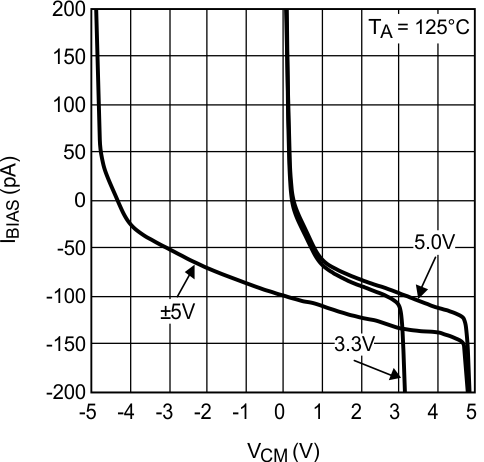 Figure 9. Input Bias Current vs VCM
Figure 9. Input Bias Current vs VCM
 Figure 11. Sinking Current vs Supply Voltage
Figure 11. Sinking Current vs Supply Voltage
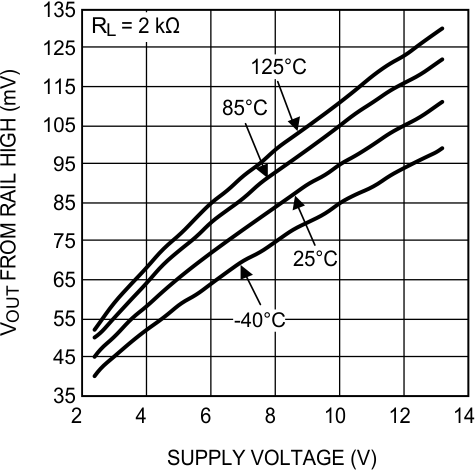 Figure 13. Output Swing High vs Supply Voltage RL = 2 kΩ
Figure 13. Output Swing High vs Supply Voltage RL = 2 kΩ
 Figure 15. Output Swing Low vs Supply Voltage RL = 2 kΩ
Figure 15. Output Swing Low vs Supply Voltage RL = 2 kΩ
 Figure 17. Output Voltage Swing vs Load Current
Figure 17. Output Voltage Swing vs Load Current
 Figure 19. Open-Loop Frequency Response Over Load Conditions
Figure 19. Open-Loop Frequency Response Over Load Conditions
 Figure 21. PSRR vs Frequency
Figure 21. PSRR vs Frequency
 Figure 23. Channel Separation vs Frequency
Figure 23. Channel Separation vs Frequency
 Figure 25. Large Signal Step Response With Gain = 10
Figure 25. Large Signal Step Response With Gain = 10
 Figure 27. Small Signal Step Response With Gain = 10
Figure 27. Small Signal Step Response With Gain = 10
 Figure 31. THD+N vs Frequency
Figure 31. THD+N vs Frequency
 Figure 33. Closed-Loop Output Impedance vs Frequency
Figure 33. Closed-Loop Output Impedance vs Frequency
 Figure 2. VOS vs VCM Over Temperature at 5 V
Figure 2. VOS vs VCM Over Temperature at 5 V
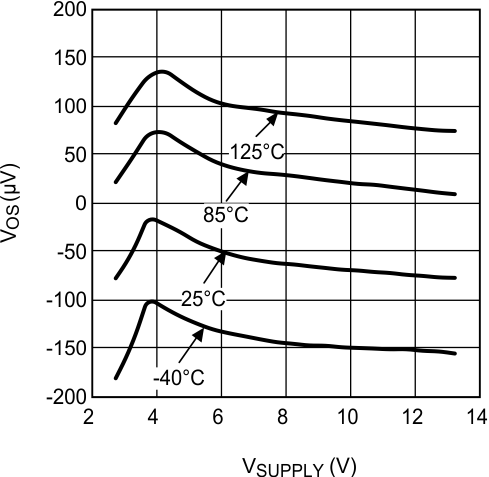 Figure 4. VOS vs Supply Voltage
Figure 4. VOS vs Supply Voltage
 Figure 6. DC Gain vs VOUT
Figure 6. DC Gain vs VOUT
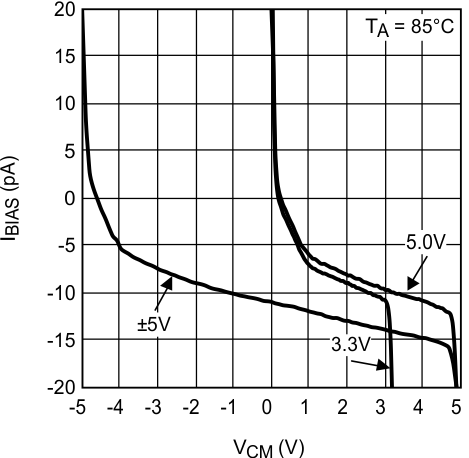 Figure 8. Input Bias Current vs VCM
Figure 8. Input Bias Current vs VCM
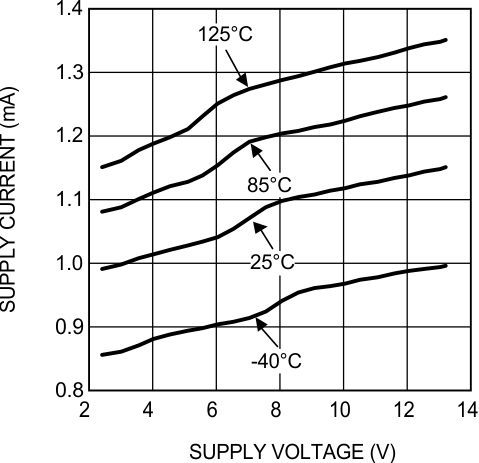 Figure 10. Supply Current Per Channel vs Supply Voltage
Figure 10. Supply Current Per Channel vs Supply Voltage
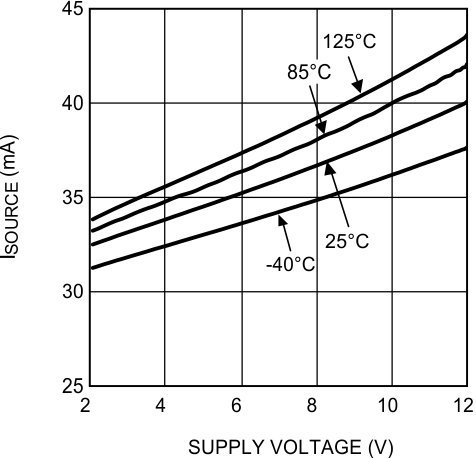 Figure 12. Sourcing Current vs Supply Voltage
Figure 12. Sourcing Current vs Supply Voltage
 Figure 14. Output Swing High vs Supply Voltage RL = 10 kΩ
Figure 14. Output Swing High vs Supply Voltage RL = 10 kΩ
 Figure 16. Output Swing Low vs Supply Voltage RL = 10 kΩ
Figure 16. Output Swing Low vs Supply Voltage RL = 10 kΩ
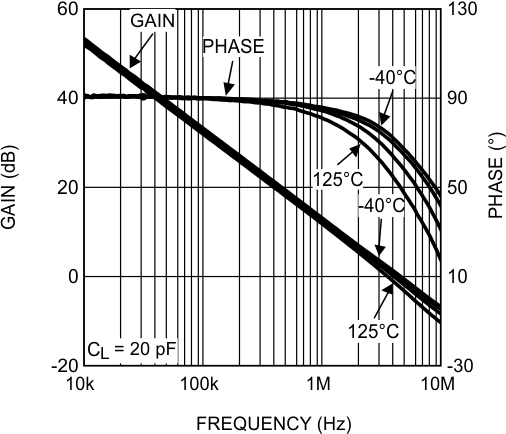 Figure 18. Open-Loop Frequency Response Over Temperature
Figure 18. Open-Loop Frequency Response Over Temperature
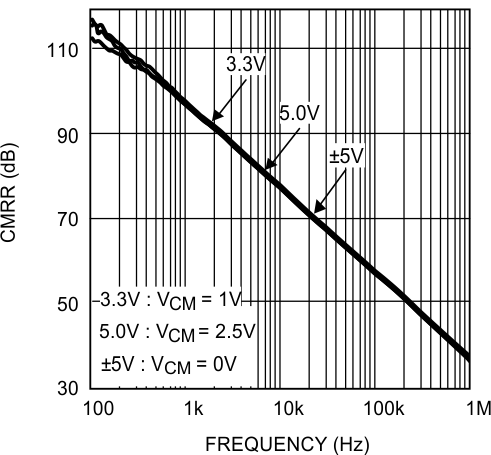 Figure 22. CMRR vs Frequency
Figure 22. CMRR vs Frequency
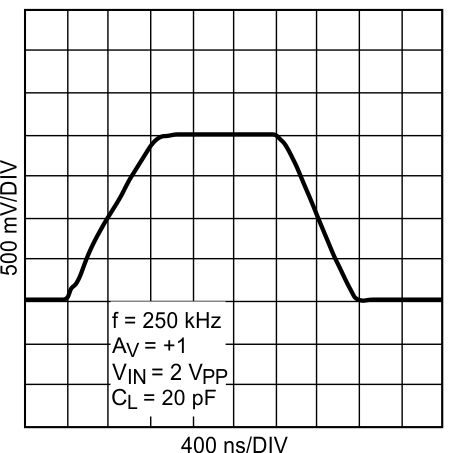 Figure 24. Large Signal Step Response With Gain = 1
Figure 24. Large Signal Step Response With Gain = 1
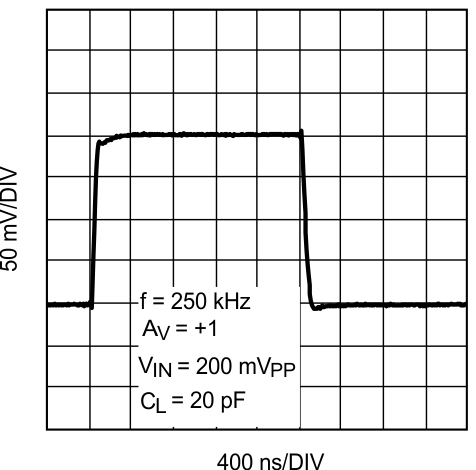 Figure 26. Small Signal Step Response With Gain = 1
Figure 26. Small Signal Step Response With Gain = 1
 Figure 28. Slew Rate vs Supply Voltage
Figure 28. Slew Rate vs Supply Voltage
 Figure 30. Input Voltage Noise vs Frequency
Figure 30. Input Voltage Noise vs Frequency
 Figure 32. THD+N vs VOUT
Figure 32. THD+N vs VOUT
7 Detailed Description
7.1 Overview
The LMV84x devices are operational amplifiers with near-precision specifications: low noise, low temperature drift, low offset, and rail-to-rail input and output. Possible application areas include instrumentation, medical, test equipment, audio, and automotive applications.
Its low supply current of 1 mA per amplifier, temperature range of −40°C to +125°C, 12-V supply with CMOS input, and the small SC70 package for the LMV841 make the LMV84x a unique op amp family and a perfect choice for portable electronics.
7.2 Functional Block Diagram

7.3 Feature Description
7.3.1 Input Protection
The LMV84x devices have a set of anti-parallel diodes D1 and D2 between the input pins, as shown in Figure 34. These diodes are present to protect the input stage of the amplifier. At the same time, they limit the amount of differential input voltage that is allowed on the input pins.
A differential signal larger than one diode voltage drop can damage the diodes. The differential signal between the inputs needs to be limited to ±300 mV or the input current needs to be limited to ±10 mA.
NOTE
When the op amp is slewing, a differential input voltage exists that forward-biases the protection diodes. This may result in current being drawn from the signal source. While this current is already limited by the internal resistors R1 and R2 (both 130 Ω), a resistor of 1 kΩ can be placed in the feedback path, or a 500-Ω resistor can be placed in series with the input signal for further limitation.
 Figure 34. Protection Diodes Between the Input Pins
Figure 34. Protection Diodes Between the Input Pins
7.3.2 Input Stage
The input stage of this amplifier consists of both a PMOS and an NMOS input pair to achieve a rail-to-rail input range. For input voltages close to the negative rail, only the PMOS pair is active. Close to the positive rail, only the NMOS pair is active. In a transition region that extends from approximately 2 V below V+ to 1 V below V+, both pairs are active, and one pair gradually takes over from the other. In this transition region, the input-referred offset voltage changes from the offset voltage associated with the PMOS pair to that of the NMOS pair. The input pairs are trimmed independently to ensure an input offset voltage of less then 0.5 mV at room temperature over the complete rail-to-rail input range. This also significantly improves the CMRR of the amplifier in the transition region.
NOTE
The CMRR and PSRR limits in the tables are large-signal numbers that express the maximum variation of the input offset of the amplifier over the full common-mode voltage and supply voltage range, respectively. When the common-mode input voltage of the amplifier is within the transition region, the small signal CMRR and PSRR may be slightly lower than the large signal limits.
7.4 Device Functional Modes
7.4.1 Driving Capacitive Load
The LMV84x can be connected as noninverting unity gain amplifiers. This configuration is the most sensitive to capacitive loading. The combination of a capacitive load placed on the output of an amplifier along with the output impedance of the amplifier creates a phase lag, which reduces the phase margin of the amplifier. If the phase margin is significantly reduced, the response is under-damped, which causes peaking in the transfer. When there is too much peaking, the op amp might start oscillating.
The LMV84x can directly drive capacitive loads up to 100 pF without any stability issues. To drive heavier capacitive loads, an isolation resistor (RISO) must be used, as shown in Figure 35. By using this isolation resistor, the capacitive load is isolated from the output of the amplifier, and hence, the pole caused by CL is no longer in the feedback loop. The larger the value of RISO, the more stable the output voltage is. If values of RISO are sufficiently large, the feedback loop is stable, independent of the value of CL. However, larger values of RISO result in reduced output swing and reduced output current drive.
 Figure 35. Isolating Capacitive Load
Figure 35. Isolating Capacitive Load
7.4.2 Noise Performance
The LMV84x devices have good noise specifications and are frequently used in low-noise applications. Therefore it is important to determine the noise of the total circuit. Besides the input-referred noise of the op amp, the feedback resistors may have an important contribution to the total noise.
For applications with a voltage input configuration, in general it is beneficial general, beneficial to keep the resistor values low. In these configurations high resistor values mean high noise levels. However, using low resistor values will increase the power consumption of the application. This is not always acceptable for portable applications, so there is a trade-off between noise level and power consumption.
Besides the noise contribution of the signal source, three types of noise need to be taken into account for calculating the noise performance of an op amp circuit:
- Input-referred voltage noise of the op amp
- Input-referred current noise of the op amp
- Noise sources of the resistors in the feedback network, configuring the op amp
To calculate the noise voltage at the output of the op amp, the first step is to determine a total equivalent noise source. This requires the transformation of all noise sources to the same reference node. A convenient choice for this node is the input of the op amp circuit. The next step is to add all the noise sources. The final step is to multiply the total equivalent input voltage noise with the gain of the op amp configuration.
If the input-referred voltage noise of the op amp is already placed at the input, the user can use the input-referred voltage noise without further transferring. The input-referred current noise needs to be converted to an input-referred voltage noise. The current noise is negligibly small, as long as the equivalent resistance is not unrealistically large, so the user can leave the current noise out for these examples. That leaves the user with the noise sources of the resistors, being the thermal noise voltage. The influence of the resistors on the total noise can be seen in the following examples, one with high resistor values and one with low resistor values. Both examples describe an op amp configuration with a gain of 101 which gives the circuit a bandwidth of 44.5 kHz. The op amp noise is the same for both cases, that is, an input-referred noise voltage of 20 nV/ and a negligibly small input-referred noise current.
and a negligibly small input-referred noise current.
 Figure 36. Noise Circuit
Figure 36. Noise Circuit
To calculate the noise of the resistors in the feedback network, the equivalent input-referred noise resistance is needed. For the example in Figure 36, this equivalent resistance Req can be calculated using Equation 1:

The voltage noise of the equivalent resistance can be calculated using Equation 2:

where
- enr = thermal noise voltage of the equivalent resistor
- Req (V/
 )
) - k = Boltzmann constant (1.38 x 10–23 J/K)
- T = absolute temperature (K)
- Req = resistance (Ω)
The total equivalent input voltage noise is given by Equation 3:

where
- en in = total input equivalent voltage noise of the circuit
- env = input voltage noise of the op amp
The final step is multiplying the total input voltage noise by the noise gain using Equation 4, which is in this case the gain of the op amp configuration:

The equivalent resistance for the first example with a resistor RF of 10 MΩ and a resistor RG of 100 kΩ at 25°C (298 K) equals Equation 5:

Now the noise of the resistors can be calculated using Equation 6, yielding:

The total noise at the input of the op amp is calculated in Equation 7:

For the first example, this input noise, multiplied with the noise gain, in Equation 8 gives a total output noise of:

In the second example, with a resistor RF of 10 kΩ and a resistor RG of 100 Ω at 25°C (298 K), the equivalent resistance equals Equation 9:

The resistor noise for the second example is calculated in Equation 10:

The total noise at the input of the op amp is calculated in Equation 10:

For the second example the input noise, multiplied with the noise gain, in Equation 12 gives an output noise of:

In the first example the noise is dominated by the resistor noise due to the very high resistor values, in the second example the very low resistor values add only a negligible contribution to the noise and now the dominating factor is the op amp itself. When selecting the resistor values, it is important to choose values that do not add extra noise to the application. Choosing values above 100 kΩ may increase the noise too much. Low values keep the noise within acceptable levels; choosing very low values however, does not make the noise even lower, but can increase the current of the circuit.
7.5 Interfacing to High Impedance Sensor
With CMOS inputs, the LMV84x are particularly suited to be used as high impedance sensor interfaces.
Many sensors have high source impedances that may range up to 10 MΩ. The input bias current of an amplifier loads the output of the sensor, and thus cause a voltage drop across the source resistance, as shown in Figure 37. When an op amp is selected with a relatively high input bias current, this error may be unacceptable.
The low input current of the LMV84x significantly reduces such errors. The following examples show the difference between a standard op amp input and the CMOS input of the LMV84x.
The voltage at the input of the op amp can be calculated with Equation 13:
For a standard op amp, the input bias Ib can be 10 nA. When the sensor generates a signal of 1 V (VS) and the sensors impedance is 10 MΩ (RS), the signal at the op amp input is calculated in Equation 14:
For the CMOS input of the LMV84x, which has an input bias current of only 0.3 pA, this would give Equation 15:
The conclusion is that a standard op amp, with its high input bias current input, is not a good choice for use in impedance sensor applications. The LMV84x devices, in contrast, are much more suitable due to the low input bias current. The error is negligibly small; therefore, the LMV84x are a must for use with high-impedance sensors.
 Figure 37. High Impedance Sensor Interface
Figure 37. High Impedance Sensor Interface
8 Application and Implementation
NOTE
Information in the following applications sections is not part of the TI component specification, and TI does not warrant its accuracy or completeness. TI’s customers are responsible for determining suitability of components for their purposes. Customers should validate and test their design implementation to confirm system functionality.
8.1 Application Information
The rail-to-rail input and output of the LMV84x and the wide supply voltage range make these amplifiers ideal to use in numerous applications. Three sample applications, namely the active filter circuit, high-side current sensing, and thermocouple sensor interface, are provided in the Typical Applications section.
8.2 Typical Applications
8.2.1 Active Filter Circuit
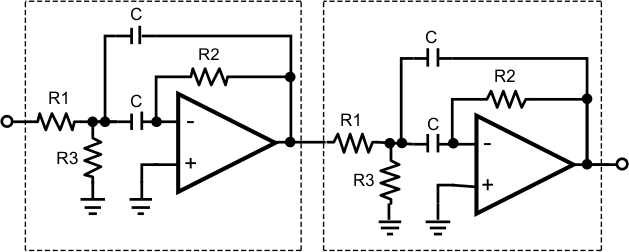 Figure 38. Active Band-Pass Filter Implementation
Figure 38. Active Band-Pass Filter Implementation
8.2.1.1 Design Requirements
In this example it is required to design a bandpass filter with band-pass frequency of 10 kHz, and a center frequence of approximately 10% from the total frequence of the filter. This is achieved by cascading two band-pass filters, A and B, with slightly different center frequencies.
8.2.1.2 Detailed Design Procedure
The center frequency of the separate band-pass filters A, and B can be calculated by Equation 16:

where
- C = 33 nF
- R1 = 2 KΩ
- R2 = 6.2 KΩ
- and R3 = 45 Ω
This gives Equation 17 for filter A:

and Equation 18 for filter B with C = 27nF:

Bandwidth can be calculated by Equation 19:

For filter A, this gives Equation 20:

and Equation 21 for filter B:

8.2.1.3 Application Curve
The responses of filter A and filter B are shown as the thin lines in Figure 39; the response of the combined filter is shown as the thick line. Shifting the center frequencies of the separate filters farther apart, results in a wider band; however, positioning the center frequencies too far apart results in a less flat gain within the band. For wider bands more band-pass filters can be cascaded.
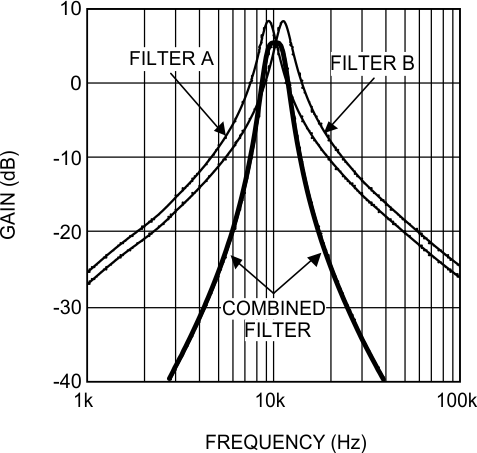 Figure 39. Active Band-Pass Filter Curve
Figure 39. Active Band-Pass Filter Curve
NOTE
Use the WEBENCH internet tools at www.ti.com for your filter application.
8.2.2 High-Side, Current-Sensing Circuit
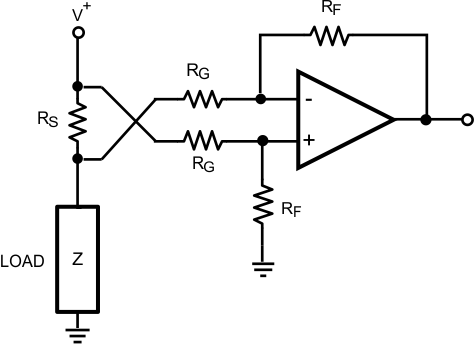 Figure 40. High-Side, Current-Sensing Circuit
Figure 40. High-Side, Current-Sensing Circuit
8.2.2.1 Design Requirements
In this example, it is desired to measure a current between 0 A and 2 A using a sense resistor of 100 mΩ, and convert it to an output voltage of 0 to 5 V. A current of 2 A flowing through the load and the sense resistor results in a voltage of 200 mV across the sense resistor. The op amp amplifies this 200 mV to fit the current range to the output voltage range.
8.2.2.2 Detailed Design Procedure
To measure current at a point in a circuit, a sense resistor is placed in series with the load, as shown in Figure 40. The current flowing through this sense resistor results in a voltage drop, that is amplified by the op amp. The rail-to-rail input and the low VOS features make the LMV84x ideal op amps for high-side, current-sensing applications.
The input and the output relation of the circuit is given by Equation 22:
For a load current of 2 A and an output voltage of 5 V the gain would be VOUT / VSENSE = 25.
If the feedback resistor, RF, is 100 kΩ, then the value for RG is 4 kΩ. The tolerance of the resistors has to be low to obtain a good common-mode rejection.
8.2.3 Thermocouple Sensor Signal Amplification
Figure 41 is a typical example for a thermocouple amplifier application using an LMV841, LMV842, or LMV844. A thermocouple senses a temperature and converts it into a voltage. This signal is then amplified by the LMV841, LMV842, or LMV844. An ADC can then convert the amplified signal to a digital signal. For further processing the digital signal can be processed by a microprocessor, and can be used to display or log the temperature, or the temperature data can be used in a fabrication process.
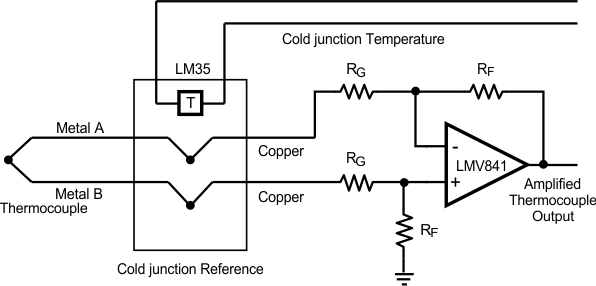 Figure 41. Thermocouple Sensor Interface
Figure 41. Thermocouple Sensor Interface
8.2.3.1 Design Requirements
In this example it is desired to measure temperature in the range of 0°C to 500°C with a resolution of 0.5°C using a K-type thermocouple sensor. The power supply for both the LMV84x and the ADC is
3.3 V.
8.2.3.2 Detailed Design Procedure
A thermocouple is a junction of two different metals. These metals produce a small voltage that increases with temperature. A K-type thermocouple is a very common temperature sensor made of a junction between nickel-chromium and nickel-aluminum. There are several reasons for using the K-type thermocouple. These include temperature range, the linearity, the sensitivity, and the cost.
A K-type thermocouple has a wide temperature range. The range of this thermocouple is from approximately −200°C to approximately 1200°C, as can be seen in Figure 42. This covers the generally used temperature ranges.
Over the main part of the range the behavior is linear. This is important for converting the analog signal to a digital signal. The K-type thermocouple has good sensitivity when compared to many other types; the sensitivity is 41 µV/°C. Lower sensitivity requires more gain and makes the application more sensitive to noise. In addition, a K-type thermocouple is not expensive, many other thermocouples consist of more expensive materials or are more difficult to produce.
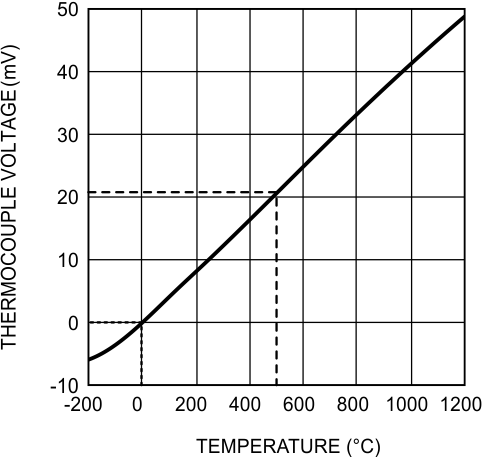 Figure 42. K-Type Thermocouple Response
Figure 42. K-Type Thermocouple Response
The temperature range of 0°C to 500°C results in a voltage range from 0 mV to 20.6 mV produced by the thermocouple. This is shown in Figure 42.
To obtain the best accuracy the full ADC range of 0 to 3.3 V is used and the gain needed for this full range can be calculated Equation 23:
If RG is 2 kΩ, then the value for RF can be calculated with this gain of 160. Because AV = RF / RG, RF can be calculated in Equation 24:
To achieve a resolution of 0.5°C a step smaller than the minimum resolution is needed. This means that at least 1000 steps are necessary (500°C/0.5°C). A 10-bit ADC would be sufficient as this gives 1024 steps. A 10-bit ADC such as the two channel 10-bit ADC102S021 would be a good choice.
At the point where the thermocouple wires are connected to the circuit on the PCB unwanted parasitic thermocouple is formed, introducing error in the measurements of the actual thermocouple sensor.
Using an isothermal block as a reference will compensate for this additional thermocouple effect. An isothermal block is a good heat conductor. This means that the two thermocouple connections both have the same temperature. The temperature of the isothermal block can be measured, and thereby the temperature of the thermocouple connections. This is usually called the cold junction reference temperature. In the example, an LM35 is used to measure this temperature. This semiconductor temperature sensor can accurately measure temperatures from −55°C to 150°C.
The ADC in this example also coverts the signal from the LM35 to a digital signal, hence, the microprocessor can compensate for the amplified thermocouple signal of the unwanted thermocouple junction at the connector.
9 Power Supply Recommendations
The LMV84x is specified for operation from 2.7 V to 12 V (±1.35 V to ±6 V) over a –40°C to 125°C temperature range. Parameters that can exhibit significant variance with regard to operating voltage or temperature are presented in the Absolute Maximum Ratings.
CAUTION
Supply voltages larger than 13.2 V can permanently damage the device.
For proper operation, the power supplies must be properly decoupled. For decoupling the supply lines, TI suggests placing 10-nF capacitors as close as possible to the operational amplifier power supply pins. For single supply, place a capacitor between V+ and V– supply leads. For dual supplies, place one capacitor between V+ and ground, and one capacitor between V– and ground.

